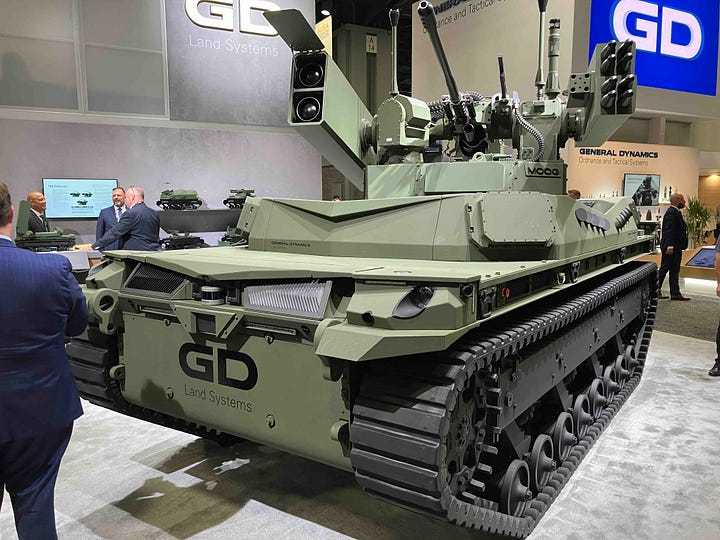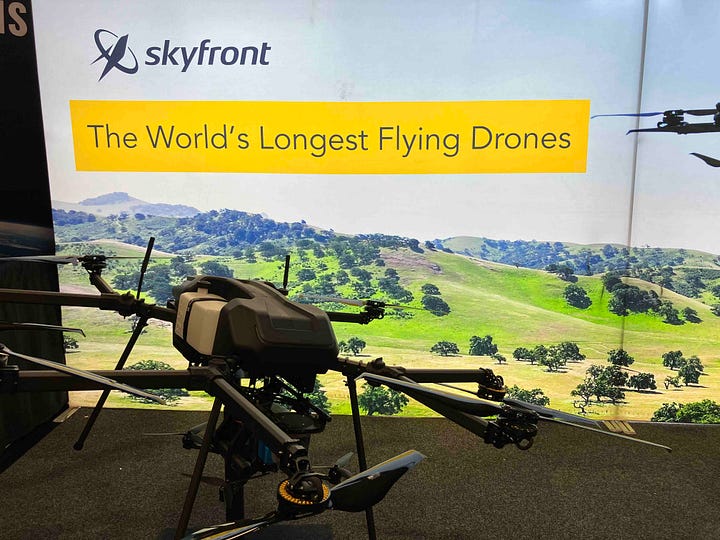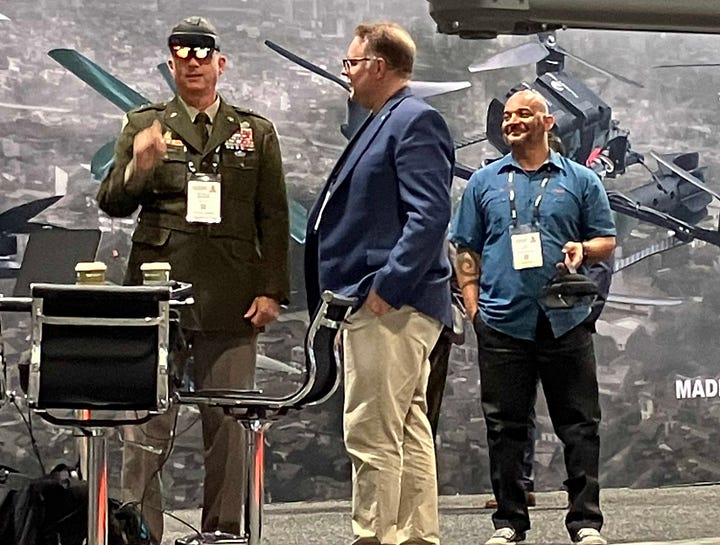The future of warfare is autonomous
At the AUSA conference in Washington, D.C., an array of unmanned weapons were on display.

The National Defense Authorization Act (NDAA) is probably the most momentous non-event in Washington. It’s a non-event because—unlike, say, keeping the government open—the NDAA always passes Congress. There are never any shutdowns, and for 63 years in a row the NDAA has become law, regardless of who controls the House and Senate. It’s momentous because the NDAA authorizes a significant amount of government spending. This year it is more than $800 billion – 15 percent of all the U.S. government’s expenditures.
Being a non-event, the NDAA rarely receives mainstream media coverage. Most Americans are unaware of how their billions of tax dollars are spent each year, and most non-Americans have likely never heard of the bill. Even among Washington insiders, scrolling through the NDAA makes for somnolent bedtime reading. This year’s bill clocked in at 973 pages, most of it stock and repetitive verbiage. But perusing the bill, one will find an increasing usage of a particular word: “unmanned” – as well as frequent instances of the acronyms “UAS” and “c-UAS,” which stand for Unmanned Aerial System and counter-Unmanned Aerial System. In layman’s terms, these refer to “drones” and the technology that makes them functional: GPS, transmission systems, cameras, software, etc. It reflects an emerging reality for the American military and militaries around the world: namely, that the future of war fighting may not involve humans.
That emerging reality was on display this week at the Association of the United States Army (AUSA) annual meeting in Washington, D.C. I attended as a military spouse, and so I will use this newsletter space to tell you a bit about what I saw. An enormous conference, AUSA attracts 33,000 people from around the world, easily filling the multi-city-block convention center in downtown D.C. The event features numerous workshops, panels and hiring events connected to the defense industry, but the centerpiece is the exhibit floor where defense contractors large and small pay top dollar to show off their newest weapons to prospective military buyers. The American military are the principal clients, but in my time on the floor I also saw officers from the Israeli military, Norwegian military, South Korean military, Japanese military, Polish military and German military. Companies such General Dynamics, SRC, Moog, SAI, Kongsberg, CACI, Honeywell and Hanwha had large displays—sometimes featuring entire tanks or helicopters—next to which small groups of industry reps huddled with military leaders explaining their latest technologies and convincing prospective buyers that, as I overhead one person say, “whatever you need, we can do.”
Within this ocean of ammunition, autonomous and unmanned weapons were ubiquitous. One company advertised “autonomous robotic targets.” Another had a large billboard that stated simply, “We Stop Drones.” Griffon Aerospace was showcasing its V250 VTOL TUAS, an unmanned aircraft that can take-off and land without a runway. Israel Aerospace Industries (IAI) was debuting its Ariel robotic combat task force, which uses AI and machine learning to redirect combat missions in real-time based on data. Skyfront was advertising the “world’s longest flying drones” and Skydio was showcasing its “AI-based autonomous drone solutions.” At the General Dynamics exhibit, a new Abrams tank was on display replete with a drone launching pad, the entire vehicle powered by electricity. When I asked the floor rep how long the vehicle takes to charge, he told me that was classified.




It was clear from the exhibits that defense contractors believe—and are hearing from their military buyers—that autonomous is the direction that warfare is heading. The evidence is in the NDAA; a cursory skim through the bill unveils at least $700 million in funding for unmanned weapons systems, including:
Future UAS Family – $53 million
Small Unmanned Aircraft - $20 million
UAS Mods – $2.2 million
Counter Small Unmanned Aerial System - $305 million
Marine Group UAS - $86 million
Marine Group UAS series - $98 million
UAS payloads - $19 million
Future Tactical Unmanned Aircraft System - $53 million
MQ-1 Gray Eagle UAS – $6.6 million
Counter Unmanned Aircraft Systems - $11.5 million
Tactical Unmanned Aerial Vehicles - $11.2 million
UAS integration and interoperability - $16 million
Small Tactical UAS - $3 million
Unmanned Aerial System - $13 million
Unmanned ISR - $6.7 million
Last year, Defense Scoops reported that the U.S. Army had identified two contractors to develop new Tactical Unmanned Aircraft Systems for rapid prototyping, at a total cost of $25 million. Military.com also reported that the army had been testing robot dogs equipped with AI-powered rifles in the deserts of Saudi Arabia. These innovations are being directed from the very top; last month, U.S. Secretary of Defense Lloyd Austin sent a memo to senior Pentagon leadership praising the efforts of the Replicator 1 initiative to “scale autonomous systems across the force,” while announcing that Replicator 2 would specifically tackle the “threat posed by small uncrewed aerial systems.” The memo asked for funding in the fiscal year 2026 budget with implementation within two years. This, in turn, is connected to a broader strategic vision called Army 2040 that calls for the Army to have widespread AI-enabled autonomous systems and human-machine operations by the year 2040.
As someone who thinks about the implications of technology on society and humanity, I could not help but wonder about the implications of these innovations. In the short term, one can expect hundreds-of-millions-of-dollars in federal funding and an eagerness from defense contractors to secure lucrative contracts. That includes household names such as Amazon, which had a booth at AUSA and has multiple lines of military business, including data centers and cloud computing. It will also likely lead to an arms race among nations to acquire ever-more technologically-advanced weaponry. Indeed, the Chinese military has already posted videos on YouTube of their soldiers using robot dogs equipped with autonomous weapons in their training exercises. The world has seen arms races before; if that history tells us anything, it is that they usually pose grave threats beyond what was foreseen in the moment.


Most importantly, one cannot help to ask what are the ethics around this? Some writers have already posed this question. Earlier this year, my friend Steven Feldstein asked in an article if these advanced weapons could be tamed before it is too late. The current war between Ukraine and Russia, for example, has seen a preponderance of unmanned weapons on the battlefield. The speed and lethality of these technologies—some estimates suggest there have been more than 600,000 casualties in the war to-date—have heightened the sense of urgency for militaries around the world to adapt, as well as spurred calls for ethical and legal frameworks. The Israeli military has been using AI-powered targeting in its war against Hamas, demonstrating the lethality of these weapons while also raising serious legal and ethical considerations. What happens when innocent civilians are killed by machines? What happens when military decisions made by algorithms go awry? Part of how wars end is through attrition; soldiers die, get wounded or get tired. What happens when each side in a conflict is replacing soldiers with machines that don’t die and don’t get tired? Will wars continue without end? Most existentially, do we want to live in a world with millions of machine guns mounted atop robots and drones, each an algorithm away from pointing a weapon at us?
From a military perspective, however, this future may be inevitable, in part because militaries are running out of people. The U.S. Army has repeatedly fallen short on recruiting, missing by 15,000 people the past few years before a slight uptick this year. The military has stated that 75 percent of young adults are unfit to serve, and anecdotally I have heard from army officers that young people are so out of shape from poor diet and lack of exercise that most cannot pass the physical fitness test. In countries with declining population growth, militaries replete with robots and autonomous systems may be essential to maintaining any form of effective defense posture. If so, contractors will be eager to tell them, “Whatever you need, we can do.”


On a personal level, I have worked with active duty military and veterans for a good portion of my professional career, as well as in my personal capacity as a military spouse. The first museum exhibit I helped curate was called Ours to Fight For, about American Jews who served in the Second World War. Later, I worked for two-and-a-half years at the Library of Congress Veterans History Project, collecting the stories of war veterans from WWI, WWII, Korea, Vietnam, Persian Gulf, Iraq and Afghanistan. I was also a Presidential Counselor of the National World War II Museum for six years. If there is one thing I’ve learned from the service members and veterans in my life, it is that war is hell. It is destructive to societies as well as to the lives, health, and souls of those who survive it. Maybe autonomous weapons will mean fewer men and women are killed or wounded in action. Maybe they become a new form of mutual assured destruction that prevents wars from being waged. Or maybe it will so remove us from the battlefield that it will make killing increasingly dispassionate, heartless and quotidian. Maybe more precise lethality will mean more deaths, not fewer, especially among civilians.
In an ideal world, there would be no wars. We would live in peace, our militaries helping us with natural disasters and humanitarian missions, not devising new ways to harm one another. On the conference floor this week, staring into the soulless lens of an AI-powered drone, such a world felt very far away.
Have a peaceful week,
-JS




Very well written, I personally agree with your insights. The scariest part of it all is tragedy of the future is already upon us, all can do as a nation is to be unified and prepared.
Wow. Your essay is so clear and powerful. Ugh!!